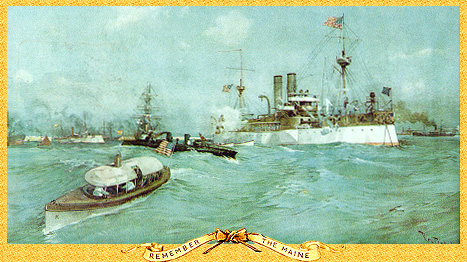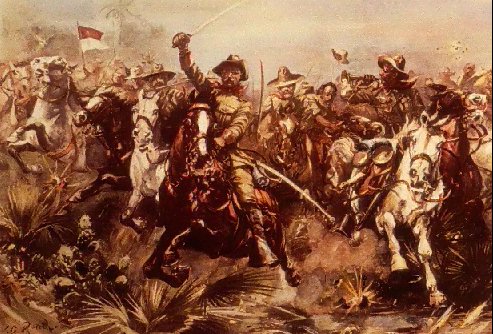
Christian
County
and
The
Spanish-American War

Christian
County
and
The
Spanish-American War

""Latham Light Guards" Company D, Third Kentucky Regiment |
In the Spanish-American War there were four classes of service men, those in the navy, those in the Cuban campaign, those in Porto Rican invasion and those in the Philippine conquest. The county was well represented in all of these contingents. The Hopkinsville Company had become Company D, Third Kentucky Regiment, known as the Latham Light Guards. It was notified to be in readiness to move and the war fever was high. The company included in its ranks many sons of both Federals and Confederates and one Federal soldier, Gus Breathitt, volunteered and was admitted.
On April 29th, a vast crowd assembled on the campus of the Clay Street School for the presentation of a flag by the children. Sadie Cohen, a little girl, presented the flag and read an original poem.
The soldiers responded with their company hell.
On May 10th, moving orders came and the Company left for Lexington
with the following roster:
| Trabue Anderson | A.B. Boulware | L.D. Brown | C.O. Brown | E.H. Brown | M.K. Bullard |
| J.M. Breathitt | Gus Breathitt | Weber Breathitt | R.H. Buckner | J.W. Ballard | J.E. Buchanan |
| C.E. Barnes | C.A. Brumfield | R.H. Claggett | J.B. Clark | J. Miller Clark | W.J. Couch, Jr. |
| W.J. Cornelius | Ed Claxton | Will Collins | J.G. Daniel | J.R. Dickerson | Henry Foster |
| Will Foster | W. N. Gaither | F.W. Gilbert | C.E.Graves | A.M. Hedges | W.T. Hardwick |
| Will Hayes | E.H. Hester | Henry Holeman | C.W. Johnson | C.E. Jackson | W.H. Jenkins |
| Stanley Long | J.G. McRae | R.F. McDaniel | Edgar Morris | Henry Merritt | E.P. Morgan |
| George Mills | William Mills | A.E. Mills | Robert Morefield | R.H. Nixon | Perry Newman |
| T.E. Overshiner | Frank O. Prowse | E.R. Powers | F.J. Pattin | Felix Robinson | S.O. Rutherford |
| E.W. Starling | G. Dennis Shaw | Everett Tandy | Jack Terry | Gano Terry | H.P. Thomas |
| Hugh Thompson | T.C. Van Cleve | Otho Vaughan | William r. Wicks | Louis Waller | C.S. Waller |
| John Winfree | W.P. Winfree Jr. | Henry Wood | Edgar Wilkes | Robert Wilkes | W.B. Witty |
| Tom Witty | J.A. Young, Jr., | Elon B. Zimmer | James Garity |
On May 10, 1898, Company D., with a roster of eighty-nine officers and men, was ordered to Lexington, Kentucky. Of these, eighty-two reported under command of Captain John Feland. Eleven of them failed to pass the required examination. Captain John Feland was not accepted as Captain and the company was merged with one commanded by Captain Noel Gaines. Second Lieutenant R. C. Payne undertook to recruit the company to eighty-two men, and in the end less than one-third were local men. The names of those finally mustered in from Christian County were:
| C.E. Jackson - Corporal | F.J. Pattin- Corporal | Gus Breathitt - Corporal | J.E. Buchanan - Corporal | Felix Robinson - Corporal | W.P. Winfree, Jr. _ Musician |
| James Wootton - Wagoner | James M. Breathitt | E.H. Brown | R.H. Bush | C.A. Brumfield | W.M. Cornelius |
| Walter Couch | Harry L. Girard | William C. Mills | E.P. Morgan | Robert F. McDaniel | F.O. Prowse |
| Otho Vaughn | William B. Witty | C.S. Waller - Mayfield | Hugh G. Thompson - Cadiz | Thomas J. Williams - Trenton |
Black Troops In War of 1898
The following named black men were enlisted in august, 1898, for Tenth
U.S. Cavalry, stationed at Santiago, Cuba:
| Will Major | William Richardson | Edward Ducker | Clarence O'Neal | John T. Thompson |
| Richard Hardin | Alex Sivells | Matt Campbell | Edward Wallace | Luther Drake |
| Albert Dade | Saint Leavell | George McReynolds | James Ricketts | Alphonso Alexander |
| Frank Mayes, Jr. | Will Haughton | George Dabney | John Norman | Forrest Hampton |
| Gardner Coleman |
They were sent to Fort McPherson, Georgia, in charge of Clarence
O'Neal.

The company of State Guards from Christian County became part of the Kentucky forces mobilized at Lexington and was later sent to Southern camps. A part of them eventually were sent to Cuba and some were in the expedition that seized the island of Porto Rico.
Among those sent to Cuba was Lieutenant Robert C. Payne, who was at Matanzas April 4, 1899, and wrote to a Hopkinsville paper: "I have been commander of the Spanish fort, San Severino, for nine weeks, in fact, ever since my arrival in Cuba. Have charge of 86 prisoners. I am going to Manila if I can get with some other regiment when this one is mustered out."
This happened a few months later and Lieutenant
Payne returned home and was commissioned to recruit a company to
go to Manila to take part in the occupation of the archipelago, the natives
having put up armed opposition to the acquirement of the Philippines under
the terms of peace with Spain. the following Hopkinsville men, most of
whom re-enlisted, were recruited in Christian County:
"Soon after my arrival, I was detailed as a clerk in the office of General E. E. Otis and remained at his headquarters for fourteen months. I then received my military discharge and was given civil employment by the Government. I was sent to General J. Franklin Bell, of Lebanon, Kentucky, who detailed me as a clerk under P.C. Marsh, in charge of the main prison in Manila. I was made chief clerk and among the prisoners I had to deal with was General Aguinaldo, the native who led the insurrection. I remained there six or eight months until Governor-General W. H. Taft, afterwards President, came over. I was then transferred to the Chief Quartermaster's department in Manila and was money clerk at the time General J. P. Sanger took the first census of the islands. I was assistant paymaster for one year in the Chief Commissary office under General L. W. V. Kennon, engineer in charge of road construction, building a road to the summer capital in the mountains. While at this, I got a vacation of three months and went to China, visited Hong Kong, Canton, Amory, Hankow, Nagasaki and Vladivostock, Russia. I was on full pay and returning to Manila I was next with the department of coast guard transportation, handling twenty vessels. While I was doing office work an incident occurred that left an impression on my mind. I got leave of absence and went to visit my company and found the boys getting ready to go on a hunt for General Cailles. I got a uniform and a gun and went along. We found Cailles fortified across the Mariquina River and opened fire. General Lawton was leading the charge and I was within fifty yards of him when he was killed by a sharpshooter. Lieut. Col. Sargent took command and we charged, backed by artillery firing over our heads and took the fort with the loss of seventy of our men killed and wounded. We found 252 dead Filipinos in the fort. General Cailles' army surrendered to General Sumner and I was present and received their guns, paying $15 apiece for them. After my services with the civil government as above stated, I returned home October 5, 1905, having been over there five years."
SOME OF THOSE WHO FIRST WENT OVER
Lannes H. Huggins, who went over in 1898, enlisted in May at Nashville, Tennessee, and went to San Francisco where there was a wait of five months. Ed L. Weathers, a sixteen-year-old boy, had succeeded ing etting into this regiment, although under weight, by the help of a friend, and during the long wait Weathers was promoed to corporal. Army food became very poor and very scarce under the contract system and finally the young corporal went to an officer above him and demanded food for his men. The officer laughed and told him where the food was stored. That night the boys broke in and helped themselves to one good meal. A commotion was made and the men were finally identified when Corp. Weathers went to the Captain and assumed responsibility for the raid. He was frowned upon and given a severe curtain lecture with a wink of the eye and left in suspense as to what else would be done. In a few days sailing orders came and the matter was dropped.
These young men and their companions landed at Manila and spent three months doing guard duty, watching the prison containing 400 soldiers and 1600 natives. They were sent to Iloilo February 11, 1899, and bombarded the town, landing while it was in flames. They were on active duty later on Panay and Cebu islands, being sent wherever needed until the insurrection was over and the islands pacified. The bands who fled to the interior and gave trouble for a year or two more were finally brought under control.
Jesup S. Tandy did not return with his companions in 1899, but like Frank P. Cook, remained in the Philippines after the fighting was over.
Only one of the young men from Christian County failed to return. John McDaniel died of disease while in the service and his body was brought home and interred in Riverside Cemetery in Hopkinsville.
THE NEW COMPANY D
The original Company D, organized in 1882, lost its identity in the
war of 1898 and in October 1899, a new Company D, Third Infantry, Kentucky
State Guards, was organized with forty-five men and mustered into service
with the following commissioned and non-commissioned officers: